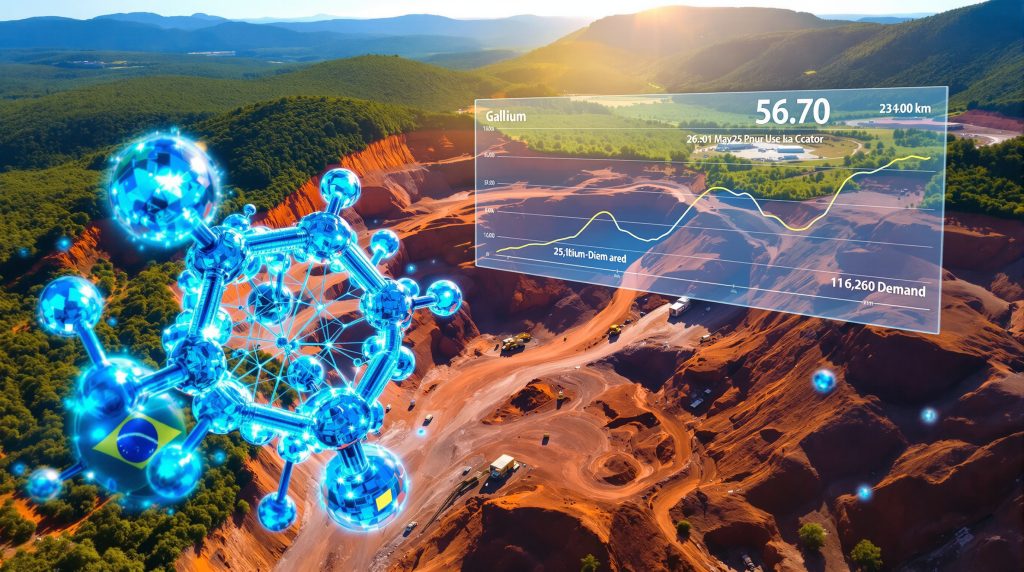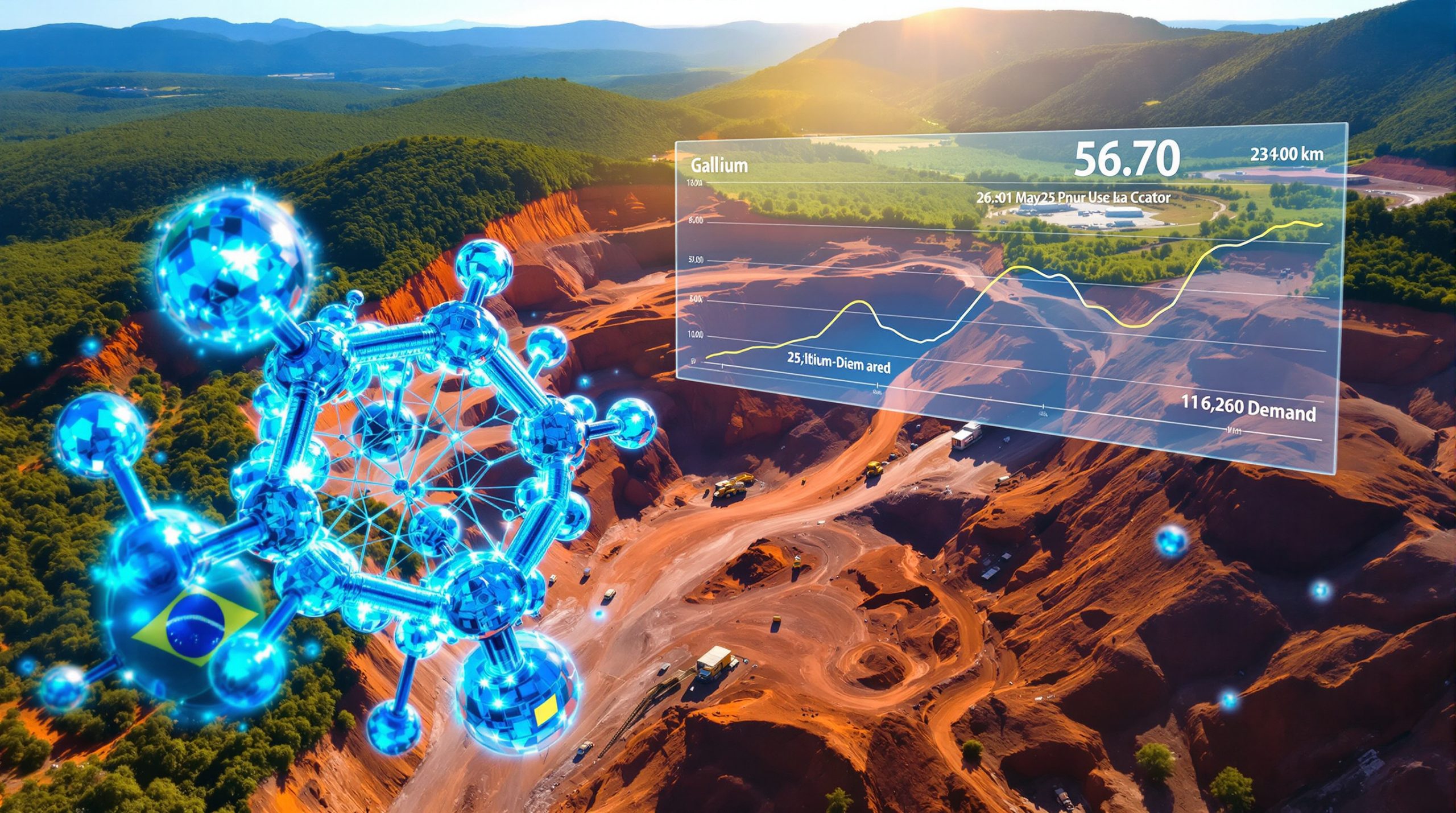Axel REE's Gallium Discovery: Brazil's First In-Situ Mineral Resource at Caladão
A historic milestone has been reached in Brazil's critical minerals strategy sector with Axel REE's announcement of the country's first in-situ gallium mineral resource at its Caladão project. This discovery represents a significant breakthrough in diversifying global gallium supply chains and positions Brazil as an emerging player in the critical minerals landscape.
A Landmark Mineral Resource Estimate
The maiden JORC-compliant Inferred Resource at Caladão has delivered impressive numbers: 100 million tonnes at 42ppm gallium, containing approximately 4,200 tonnes of gallium metal. This resource covers roughly 33 square kilometers, with geological indicators suggesting potential for expansion across an additional 58 square kilometers of the property.
Paul Dickson, Axel REE's non-executive chair, highlighted the exceptional nature of this discovery: "The maiden gallium resource we have defined at Caladão is unique, with its own discrete layer of mineralisation at surface."
This discovery represents not just a significant quantity of gallium but marks the first documented in-situ gallium mineral resource in Brazilian history, classified according to international standards by SRK Consulting.
Strategic Importance in Global Supply Chains
The Caladão gallium resource takes on additional significance in today's geopolitical climate. As one of the world's largest standalone gallium inventories outside China, it emerges at a critical time when Western nations are actively seeking supply chain alternatives.
Recent Chinese export restrictions have highlighted vulnerabilities in the gallium supply chain, creating market uncertainty for industries dependent on this critical metal. The Brazilian discovery provides a potential pathway toward greater supply diversity for manufacturers in semiconductor, LED, and advanced electronics sectors.
Brazil's government has been working to transition the country toward domestic production of strategic minerals, making this discovery align perfectly with national resource development priorities.
How Does the Caladão Project's Geology Support Gallium Production?
The geological characteristics of the Caladão deposit present several advantages that could streamline potential production operations.
Surface Layer Mineralization Advantages
Among the most promising aspects of the Caladão discovery is its shallow setting. The gallium mineralization occurs near the surface, which geological assessments suggest would result in low strip ratios for any future mining operation. This surface proximity creates favorable conditions for potential low-cost open pit mining approaches.
Interestingly, the gallium mineralization exists as a discrete layer positioned above the rare earth mineralization within the same project area. This clear geological boundary helps define the resource classification guide and potentially simplifies extraction planning.
The ionic clay-hosted nature of the gallium resource presents significant processing advantages compared to traditional gallium sources. This mineral form typically requires less aggressive processing methods, potentially reducing both costs and environmental impacts.
Metallurgical Testing Results
Initial metallurgical work has yielded encouraging results for the Caladão project. Leach tests confirm the gallium's extractability using standard techniques commonly employed in the mining industry. These tests specifically demonstrated positive gallium recoveries under acidic conditions, suggesting conventional processing approaches may be viable.
The company is developing a two-stage leaching process aimed at optimizing the extraction of both gallium and rare earth elements from the deposit. This approach recognizes the potential for synergistic production of multiple critical minerals from the same resource.
Current testing is exploring the viability of heap leach methods similar to established Chinese practices for similar deposit types. If successful, this approach could significantly reduce both capital and operating expenses compared to more complex processing routes.
What Makes Caladão's Gallium Resource Unique?
The Caladão gallium discovery stands apart from most global gallium resources in several important ways.
Distinctive Geological Characteristics
Unlike most gallium production, which comes as a byproduct from aluminum refining, the Caladão resource represents a standalone gallium deposit not associated with alumina or bauxite processing. This independence from aluminum production chains provides greater flexibility in development planning and potential market positioning.
The discrete mineralization layer at the surface features well-defined boundaries, simplifying resource modeling and extraction planning. This clearly delineated gallium zone overlies rare earth mineralization within the same project area, creating opportunities for complementary resource development.
This discovery came during the company's initial 2024 drilling campaign, suggesting the potential for additional discoveries as exploration continues across the broader property. The resource remains open in multiple directions, presenting opportunities for future expansion.
Economic Processing Potential
The project's co-located gallium and rare earth resources enable a combined development strategy that could enhance overall project economics. This multi-mineral approach allows for shared infrastructure, processing facilities, and operational overhead across both resource types.
Heap leaching methods being explored could provide significant capital and operating cost advantages over more intensive processing approaches. This technology, if successfully implemented, would mirror similar approaches used in Chinese operations processing comparable materials.
The company has established collaboration with Brazil's national mineral technology research organizations to advance beneficiation techniques specific to this resource type. This partnership leverages national expertise in mineral processing optimization.
Ongoing metallurgical work focuses on enhancing recovery rates and refining processing parameters to maximize gallium extraction while minimizing environmental impacts and operational costs.
Where is the Caladão Project Located and Why Does it Matter?
The strategic location of the Caladão project provides numerous advantages that could support successful development.
Strategic Location in Brazil's Mining Hub
The project is situated in Minas Gerais state's "Lithium Valley" region, an area rapidly gaining recognition for its critical mineral potential. This location places it within Brazil's most established mining jurisdiction, with a centuries-long history of mining industry innovation.
This regional positioning provides access to established mining infrastructure, skilled labor, and technical services essential for resource development. The surrounding area already supports multiple mining operations, creating potential synergies in logistics and supply chains.
The project forms part of Brazil's growing critical minerals sector, which the government has identified as a strategic development priority. This alignment with national resource strategy could facilitate permitting and development pathways.
The total project tenure covers an impressive 430 square kilometers, providing ample space for resource expansion, infrastructure development, and environmental management within a single property package.
Geopolitical Advantages
Brazil represents a stable mining jurisdiction with low sovereign risk compared to many other resource-rich nations. The country's established mining code, regulatory frameworks, and court systems provide investors with greater certainty regarding project development pathways.
The nation maintains strong strategic ties with Western markets seeking critical mineral supply diversification. These relationships could support future offtake agreements, project financing, and market access for Caladão's gallium production.
Brazil's position as a democratic, market-oriented economy aligns with Western efforts to secure critical mineral supplies from allied nations. This geopolitical alignment could potentially provide preferential access to technology manufacturing markets seeking gallium sources outside Chinese control.
What's Next for Axel REE's Gallium Development?
The Caladão project stands at the beginning of its development journey, with several important workstreams advancing simultaneously.
Ongoing Technical Development
In parallel with the gallium resource announcement, a rare earth resource estimate for the property is currently in progress. This complementary assessment will provide a more complete picture of the project's mineral inventory and development potential.
Final geological modeling is underway to create a comprehensive resource definition that integrates both gallium and rare earth components. This integrated approach will support more holistic modern mine planning.
Metallurgical optimization work continues to enhance recovery rates and refine processing parameters. These studies aim to maximize metal recovery while minimizing environmental impacts and operational costs.
The exploration team is conducting assessments of additional gallium-rich areas within the broader tenement package. This work could potentially expand the resource base beyond the initial discovery area.
Strategic Positioning in Critical Minerals Market
The Caladão project has the potential to emerge as a globally significant gallium source outside China's sphere of influence. This positioning aligns with growing market demand for supply chain diversification in critical minerals.
The project could support high-tech manufacturing growth in Western nations by providing secure access to gallium, a metal essential for advanced electronics, renewable energy technologies, and defense applications.
The resource is well-positioned to address supply constraints in semiconductor and electronics industries that have been highlighted by recent export restrictions and supply chain disruptions.
This initial resource establishes a foundation for future offtake agreements and project financing discussions with potential strategic partners in technology manufacturing sectors dependent on gallium inputs.
What is Gallium and Why is it Considered Critical?
Understanding gallium's applications and supply chain challenges provides important context for evaluating the significance of the Caladão discovery.
Technical Applications and Importance
Gallium serves as an essential component in semiconductor manufacturing, particularly for gallium arsenide (GaAs) and gallium nitride (GaN) compounds that form the foundation of modern electronics.
The metal plays a crucial role in 5G infrastructure development, with gallium-based components enabling the high-frequency performance required for next-generation telecommunications networks.
In the renewable energy sector, gallium compounds are vital for high-efficiency solar panels and LED lighting technologies that reduce global energy consumption.
The automotive industry increasingly relies on gallium nitride power electronics that enable more efficient electric vehicle systems, supporting the global transition toward electrified transportation.
Defense technologies and aerospace applications depend on gallium-based components for radar systems, satellite communications, and various specialized electronic systems where performance requirements exceed the capabilities of silicon-based alternatives.
Supply Chain Vulnerabilities
The global gallium market has historically been dominated by Chinese production and processing capabilities, with limited production elsewhere. This concentration creates inherent supply chain vulnerabilities for Western manufacturers.
Recent export restrictions implemented by China have highlighted these vulnerabilities, causing market uncertainty and price volatility for industries dependent on gallium inputs.
Limited standalone gallium resources exist globally, with most production coming as a byproduct of aluminum processing. This production model ties gallium availability to aluminum market dynamics rather than direct gallium demand.
The technological importance of gallium continues to grow while supply diversification has lagged, creating potential bottlenecks for critical industries including telecommunications, renewable energy, and defense electronics.
How Does Axel REE's Discovery Compare to Other Global Gallium Resources?
The Caladão gallium resource presents several distinctive characteristics when viewed in the context of global gallium supply.
Global Context and Comparative Analysis
The Caladão project represents one of the few standalone gallium resources not tied to aluminum production. This independence from aluminum refining gives it different economic drivers than traditional gallium recovery operations.
The resource's scale appears significant compared to other known gallium deposits, though comprehensive global comparisons are challenging due to limited public data on many gallium resources.
The surface mineralization at Caladão potentially offers cost advantages compared to deeper deposits or those requiring more complex extraction methods. This near-surface position could translate to lower mining costs and faster development timelines.
The combined gallium-rare earth potential enhances overall project economics by allowing shared infrastructure and processing facilities across multiple valuable mineral streams.
Production Potential Timeline
The project remains in early stages, with significant development work required before production could commence. The current resource classification as "Inferred" indicates additional drilling and assessment work will be needed to advance toward production decisions.
Metallurgical optimization studies are ongoing to determine definitive recovery rates and processing requirements. These technical parameters will significantly influence project economics and development pathways.
Processing flowsheet development continues to advance, with various extraction approaches under evaluation to determine the most efficient and environmentally sound production methods.
The company is exploring potential integration with rare earth element production to create synergistic processing advantages and improved overall project economics.
FAQs About Axel REE's Gallium Discovery
What is the current global gallium supply situation?
While specific production figures vary by source, global gallium production is limited to a few hundred tonnes annually. The metal's production remains highly concentrated, with China controlling the vast majority of refining capacity.
Recent export restrictions have created supply uncertainties for manufacturers outside China, highlighting the vulnerabilities in current supply chains.
Limited alternative sources exist outside Chinese control, making new discoveries like Caladão particularly significant for supply diversification efforts.
How does gallium extraction from ionic clays differ from traditional sources?
Traditional gallium production primarily comes as a byproduct from bauxite processing within the aluminum industry. This production method ties gallium availability to aluminum market dynamics.
Ionic clay extraction, as proposed for Caladão, uses direct leaching methods that can selectively recover gallium and other valuable metals through relatively simple processing techniques.
This extraction approach potentially offers lower environmental impacts compared to conventional bauxite refining, which typically involves energy-intensive processing and generates significant waste materials.
The co-production opportunity with rare earth elements provides economic advantages not available in traditional gallium recovery operations.
What are the next development milestones for the Caladão project?
Key upcoming milestones include completion of the rare earth resource estimate, which will provide a more comprehensive picture of the property's mineral inventory.
Advancement of metallurgical testing and process optimization represents another critical workstream, as recovery rates and processing costs will significantly influence project economics.
The company may pursue expansion of the resource through additional drilling programs, particularly in areas adjacent to the current resource boundary.
A preliminary economic assessment of combined gallium-rare earth production would represent a significant milestone in determining the project's commercial viability.
What market factors might influence the project's development?
Growing demand for gallium in semiconductor and electronics industries, particularly for applications in 5G networks, electric vehicles, and renewable energy technologies, could create favorable market conditions.
Supply chain diversification initiatives from Western nations concerned about critical mineral security could potentially support project financing and development through strategic partnerships.
The project may benefit from premium pricing for non-Chinese gallium sources if manufacturers place value on supply chain security and geographic diversification.
The strategic importance of gallium in green technology and defense applications could attract support from governments and industries seeking secure access to this critical metal.
Beyond the Resource: Brazil's Critical Minerals Future
The Caladão gallium discovery represents more than just a single resource—it signals Brazil's emerging role in global critical minerals supply chains. As technology manufacturers worldwide seek supply chain resilience, developments like this could position Brazil as an increasingly important partner in energy transition in minerals.
For those watching Brazil's mining sector evolution, this discovery highlights the untapped potential that remains within one of the world's most mineral-rich nations. Beyond traditional commodities like iron ore and gold, Brazil's geology holds promise for the very materials that will power next-generation technologies.
While the Caladão project's development journey is just beginning, its emergence demonstrates how changing global priorities around critical mineral security are creating opportunities for new resource discoveries and development pathways in stable, democratic mining jurisdictions.
Want to Catch the Next Major Mineral Discovery Before the Market?
Discovery Alert's proprietary Discovery IQ model provides instant notifications on significant ASX mineral discoveries, turning complex geological data into actionable investment opportunities. Explore how historic discoveries have generated substantial returns by visiting the Discovery Alert discoveries page and position yourself ahead of the market.




